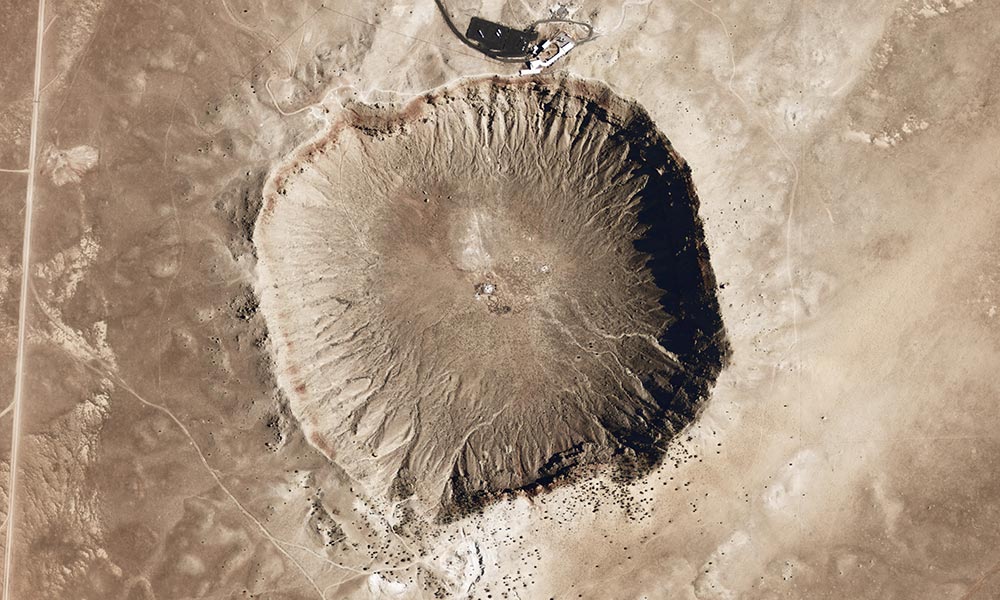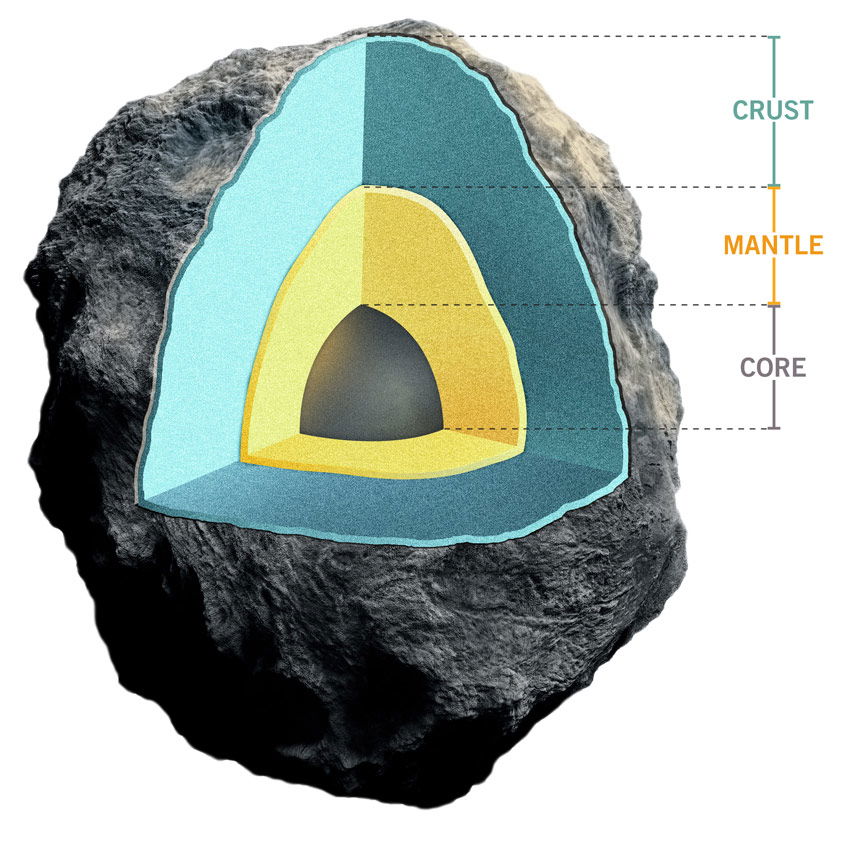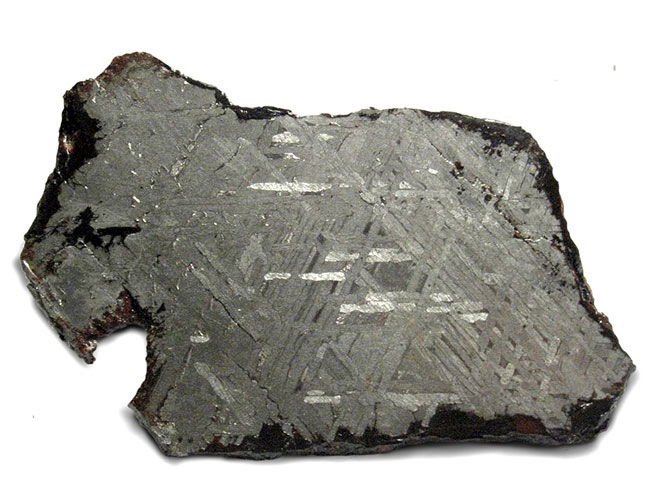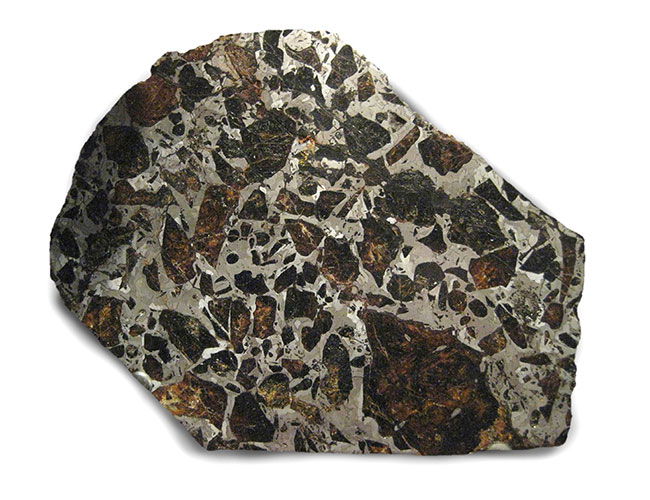Misunderstood Messengers from Space
Planetary Geology
Meteorites are considered leftovers from the solar system’s early creation and conventionally dated at 4.56+ billion years. They have an amazing story to tell, but it has been misunderstood.
Have you ever sat gazing at the stars on a clear night when a bright streak flashed across your vision, barreling toward the earth? “Falling stars” inspire wonder and mystery, but at times they also inspire terror.
In the cold early morning of February 15, 2013, a bright fireball exploded over Chelyabinsk, Russia, causing a sonic boom that damaged thousands of buildings and injured nearly 1,500 people due to shattered glass and other debris. No one saw it coming, a meteor approximately 65 feet (20 m) across and weighing over 13,000 tons (12,000 metric tons)—the largest object to smash into earth’s atmosphere in over a century.
This meteor disintegrated before it struck the earth’s surface. But we have not always been so lucky. Scars litter the earth, where extraterrestrial rocks survived the heat of entry. Since the 1960s geologists have found more than 185 craters that were formed by meteorite impacts at some point in earth’s history. (Some are huge; see sidebar below) Many textbooks and museums, in fact, claim one of these impacts wiped out the dinosaurs. The threat is real. Space agencies have devoted lots of taxpayers’ dollars to search the skies and warn us when the next rock might hit.
These messengers from space remind us that life is fragile. God warns that final judgment is coming, including falling stars, and mankind can’t do anything to stop it (Isaiah 34:4; Matthew 24:29; Revelation 6:13).
Meteorites have another practical benefit. They provide physical evidence about the composition of the rest of our solar system. Imagine if you could pluck rocks from other planets and asteroids and transport them back to earth. In a sense, that’s what has happened! Of more than 52,000 meteorites, scientists believe most have come from asteroids, but 134 are thought to have come from the moon, and 132 from Mars. By studying the makeup of these rocks, scientists hope to understand their origin and how they got to earth.
The First Proven Meteorite Crater
Arguably the best-preserved impact crater on earth is located near Flagstaff, Arizona. This massive hole in the ground is about 3,900 feet (1200 m) wide and 570 feet (170 m) deep, with a high rim that rises 148 feet (45 m) above the surrounding desert plains. Discovered by European settlers in the 1800s, it was initially ascribed to the actions of a volcano.

For years, the Barringer Crater puzzled geologists, who found it hard to believe it formed instantly. NASA
Since evolutionary scientists assume geologic processes take long periods of time, they found it hard to imagine that such a big crater could form instantly. When iron meteorites were later discovered in the area, Grove Gilbert, the chief geologist for the US Geological Survey, came to investigate. He concluded the crater was the result of a volcanic steam explosion, not a meteorite. He thought that if the crater had been produced by an iron meteorite, a large portion of the meteorite should still be buried in the crater and cause a magnetic anomaly. Both were missing.
A mining engineer, Daniel Barringer, thought differently. In 1903 he staked a mining claim over the land. He believed a meteorite lay buried beneath the crater and might have 100 million tons of iron, worth more than a billion dollars back then. Barringer spent 27 years trying to locate it and prove his theory, but nothing was found.
It wasn’t until 1960 that research on nuclear test sites by Eugene Shoemaker confirmed the meteorite impact origin of this crater. His key discovery was the presence of rare minerals that are found only in rocks that have been severely shocked by nuclear explosions much more intense than volcanoes can produce.
We now know that an iron meteorite, approximately 150 feet (45 m) across and weighing 300,000 tons (270,000 metric tons), must have caused the crater. It struck earth’s atmosphere with such force—equivalent to at least 2.5 megatons of TNT, or 150 times the force of the atomic bomb at Hiroshima—that most of the meteorite vaporized instantly. Only a few fragments survived.
Evolutionists believe asteroids are leftovers from the rotating disk of gas and dust that supposedly formed planets billions of years ago. Creationists, on the other hand, believe the Bible, which reveals that God filled the solar system with these wonderful objects on Day Four of creation, just 6,000 years ago. They expect the evidence to point toward God’s recent creation at a single moment.
The evidence is in. Meteorites do, indeed, have a date of origin that is similar to rocks at the roots of continents. But a big puzzle remains. The radiometric ages consistently fall around 4.56–4.57 billion years old. How do we reconcile this with the Bible’s timeframe?
We have some more digging to do. But the possibilities are exciting. By looking closer at all the evidence, we should be able to demonstrate how radiometric dates must be adjusted to yield the correct dates in line with Scripture.
What Are Meteorites?
It has taken a long time to narrow down which rocks came from outer space. Meteorites are made out of two main materials. The vast majority are stony meteorites, which consist of silicate minerals like earth rocks. The other material is iron, predominantly iron-nickel metal alloys, like the earth’s core. Stony meteorites are further subdivided into meteorites that contain chondrules and those that do not. (Chondrules are small rounded globules of silicate minerals.)
Most meteorites are stony with chondrules, called chondrites (86%). Most of the rest are stony without chondrules, called achondrites (8%). A few are iron and stony-iron meteorites (6%). They range in size from about an ounce (28 g) to the largest known meteorite, discovered in 1920 by a farmer plowing his field in Namibia, Africa, which weighed 66 tons (60 metric tons).
Where Do Meteorites Come From?
Creation scientists assume that meteorites were formed after the Creation Week, as a result of collisions in space. We suspect that when space debris slams into solar system objects (like asteroids, moons, or planets) rocks are flung out into space. If the earth runs into one of those rocks and the rock makes it to the earth’s surface, it is termed a meteorite. However, no one has actually observed this process. We just see the results—craters on large asteroids, moons, and planets; and meteorites lying on the earth.
Each planet, moon, comet, and asteroid has unique traits. So in theory geologists can compare the minerals and chemistry of meteorites to determine where they came from. But it’s not so simple. We still have a lot to learn about asteroids and other objects in the solar system, and we don’t fully understand the dynamics of meteorite travel.
If we find a meteorite on the ground but never see the original meteor impact, it’s called a meteorite find. It is far better if we can witness the meteor hitting the earth and then collect the pieces. These are termed meteorite falls, and they’re very rare (only around 1,100 documented so far). They’re a geologist’s dream because we can use them to reconstruct the content of the meteor before it broke up.
Meteorites were apparently formed after the Creation Week as a result of collisions in space.
Astronomers would also like to know the meteor’s path, but what’s the chance we’d ever detect a flying rock in the darkness of space before it actually gets here? Well, on October 6, 2008, astronomers got their chance. An astute American astronomer detected a small 13-foot-wide (4 m) asteroid, called 2008 TC3, zooming toward earth 19 hours before impact. Early the next morning, alerted eyewitnesses and science laboratories recorded the fireball that formed when the asteroid hit the earth’s atmosphere above the Nubian Desert of Sudan, Africa. A few seconds later, 23 miles (37 km) above the earth, the asteroid shattered in a series of explosions. Approximately 700 small fragments were subsequently recovered from what is now known as the Almahata Sitta meteorite. Using all these data, astronomers were able to link this meteorite to a class of “F-type asteroids” found in the asteroid belt between Mars and Jupiter.
In 2010 the Japanese spacecraft Hayabusa successfully returned to earth with fine particles collected in 2005 from the surface of the “S-type” near-earth asteroid 25143 Itokawa. Those dust particles were analyzed and found to be identical to a class of chondrite meteorites.
In 2011 astronomers went a step further. They sent a spacecraft into orbit around a “V-type” asteroid to confirm whether it is the source of a group of achondrite meteorites. They chose 4 Vesta, the second-largest asteroid in the solar system. It’s so big that it has an iron core, a stony mantle, and a basalt crust. Geologists suspect this asteroid’s crust and upper mantle are the main source of howardite, eucrite, and diogenite (HED) meteorites on earth. Eucrite meteorites are similar to the basalts in earth’s crust (the common black volcanic lava rock). Some diogenite meteorites are similar to earth’s mantle rocks, brought to the surface by volcanic eruptions. (Howardites consist of fragments of the other two types of rock, cemented together.) Several large chunks of 4 Vesta were broken off where space debris slammed into its surface. The orbiting spacecraft Dawn confirmed that these impacts likely produced the HED meteorites that fell to earth.
It is generally thought that many iron meteorites came from the iron cores of asteroids like 4 Vesta, too, but more research needs to be done.
Meteorites and the Age and Origin of the Earth
Contrary to what you would intuitively think, geologists did not establish the age of the earth by the radioactive dating of earth rocks. Rather, they dated meteorites. If both were formed at the same time, either one can be dated. But it’s hard to find original rocks on earth because our planet is so dynamic.
In 1956 Clair Patterson of the California Institute of Technology reported an earth age of 4.55 ± 0.07 billion years based on his analyses of lead atoms from the radioactive decay of uranium in five meteorites. Three are stony meteorites. (These famous meteorites actually have individual names: Nuevo Laredo from Mexico; Modoc from Kansas, USA; and Forest City from Iowa, USA.) Two are iron meteorites (Canyon Diablo from Meteor Crater in Arizona, USA; and Henbury from central Australia).
He also analyzed ocean sediment, which contains lead atoms from uranium radioactive decay in rocks mixed together throughout the earth’s history. This ocean sediment lined up with the plot of the lead atoms in the meteorites, so he concluded the age of those meteorites must match the age of the original rocks on the earth. This date has been declared to be the age of the earth.
In the six decades since, many more radioactive dates of meteorites have agreed with their postulated age of 4.56–4.57 billion years. Furthermore, secular geologists now believe the rounded globules of silicate minerals, called chondrules, are primordial “droplets” that condensed from the original disk from which our solar system supposedly evolved.
So what are Bible-believing Christians to make of all this?
A Biblical Creation Perspective
God’s eyewitness Genesis account of creation clearly tells us that the earth was created on Day One, and the rest of the solar system was made on Day Four. So we know that the evolutionary disk view is wrong. To find the correct interpretation, we need to revise the starting assumptions so they line up with the infallible account in Scripture.
Radioactive dating must assume the starting conditions at time zero when radioactive decay began. All original material had to have an initial composition, but we don’t know what it was (whether we’re evolutionists or creationists). If we are wrong, then all the calculated radiometric dates will be wrong.
It is not entirely clear from the creation account whether the matter from which the planets and stars were constructed was made on the first or fourth day of creation. It is possible, on the one hand, that the only matter created on Day One of the Creation Week was the matter used to construct the earth—the rest being created on Day Four. On the other hand, it is also possible that God created all the matter of the universe at the beginning of Day One. He then used part of it to fashion the earth on that same day, and reserved the rest to fashion the remainder of the universe on Day Four.
Either way, the processes God subsequently used to shape and reshape the earth may not have affected the matter He used to form the remainder of the universe. The earth was reshaped on Day Three when God made the dry land—presumably by redistributing and raising the rocky materials that had been under the globe-covering waters on Days One and Two. But the primordial material in space was unaffected from its creation on Day One. God then reshaped the earth again during His later global Flood judgment, again redistributing its rocky materials. This means that such things as radiometric dates on earth rocks might have been affected very differently from rocks from asteroids, the moon, and Mars.
Therefore meteorites might actually help us determine when the matter of astronomical bodies was created. In the second interpretation, asteroids would have been created on Day Four from the same material the earth was constructed from on Day One. In such a scenario the chemistry of asteroids—and the meteorites derived from them—would reflect the created composition of both the asteroids and the earth. The supposed 4.56–4.57 billion-year ages of meteorites would then represent the composition of the earth at its initial creation. This, in turn, could explain why the lead atoms in the ocean sediments of the earth seem to line up with the lead atoms in meteorites.
Someday we may be able to use meteorites to recalibrate all radiometric dates to match their true history.
So maybe meteorites are messengers from space providing clues about the composition of the original creation. Someday we may be able to use this information to recalibrate all radiometric dates to match their true history, which accords with the Bible’s timetable.
One thing is for sure. Meteorites remind us that the universe is temporary, and life could end at any time. Our only hope is the all-powerful Creator who dwells independently of this universe and controls everything in it. Genesis simply says of His power, “He made the stars also” (1:16), as though making the trillions of heavenly bodies was no big deal. And He knows all their names and oversees their movements (Psalm 147:4). This same Creator God knows the numbers of hairs on our heads (Matthew 10:30), so we can be confident in His care for us, no matter where the next meteorite might fall.
Answers Magazine
April–June 2016
How well do you know the views of modern creationists? Test your knowledge and then discover how Christians can effectively share the gospel with homosexuals.
Browse Issue SubscribeRecommended Resources

Answers in Genesis is an apologetics ministry, dedicated to helping Christians defend their faith and proclaim the good news of Jesus Christ.
- Customer Service 800.778.3390
- © 2024 Answers in Genesis









